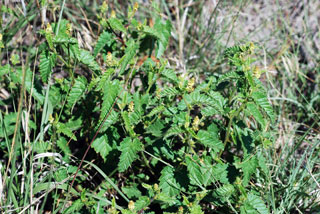BETONY NOSEBURN
|
 |
| File Size: 156 KB |
|
|
|
Tragia betonicifolia Nutt.
|
| Russell County, Kansas |
| Perennial |
| Height: 6-22 inches |
| Family: Euphorbiaceae - Spurge Family |
| Flowering Period: June, July, August |
|
| Stems: | | Decumbent to ascending or erect; sap watery. | | Leaves: | | Cauline, alternate, simple; stipules present; petiole .2 to 1 inch; blade ovate to ovate-lanceolate or triangular-lanceolate, .3 to 2.4 inches long, .28 to 1.2 inch wide, base cordate to truncate, margins serrate, tip acute. | | Inflorescences: | | Racemes, axillary or terminal, .4 to 2.4 inches; staminate and pistillate flowers on same plant, pistillate flowers proximal and staminate flowers distal; staminate flowers 15-80 per raceme, pistillate flowers 1-2 per raceme; staminate bracts lanceolate, 1/25 to 1/12 inch; pistillate bracts 1/16 to 1/12 inch. | | Flowers: | | Staminate flowers greenish: pedicel short; sepals 3-4, 1/20 to 1/10 inch; petals 0; stamens 3(-4). Pistillate flowers greenish: sepals 6, connate basally, lanceolate, 1/13 to 1/5 inch, longer than gynoecium (collective term for the pistil(s) of a flower); petals 0; styles 3, connate proximally more than 1/2 their lengths, simple. | | Fruits: | | Capsules 3-lobed, not enveloped by persistent bracts, 1/6 to 1/5 inch long, 1/4 to 2/5 inch wide; seeds dark brown with light brown streaks, globose to ovoid, 1/8 to 1/6 inch. | | Habitat: | | Rocky to gravelly or sandy tallgrass and mixed-grass prairies, glades, clearings in oak-hickory woodlands, occasionally rocky old fields. | | Distribution: | | East 3/5 of Kansas | | Origin: | | Native | | Comments: | | The herbage is covered with stiff stinging hairs that are painful when touched, thus the common name nose burn. Tragia, for Hieronymus Bock, a German botanist whose Latinized name was Tragus and betonicifolia, with leaves like those of betony, Stachys. | | | | See also catnip noseburn |
|
| Betony noseburn |  | | 151 KB | | Ru |
| | Betony noseburn fruit |  | | 44 KB | | Russell County, Kansas |
| | Betony noseburn flowers |  | | 35 KB | | Russell County, Kansas |
| | Betony noseburn |  | | 104 KB | | Russell County, Kansas |
| | Betony noseburn |  | | 115 KB | | Russell County, Kansas |
| | Betony noseburn fruit |  | | 49 KB | | Russell County, Kansas |
| | Betony nose burn leaves |  | | 127 KB | | Wabaunsee County, Kansas |
| | Betony noseburn habit |  | | 166 KB | | Ottawa County, Kansas |
| | Betony noseburn flowering |  | | 142 KB | | Ottawa County, Kansas |
| | Betony noseburn |  | | 118 KB | | Ottawa County, Kansas |
|
|
|
|
|
|
|